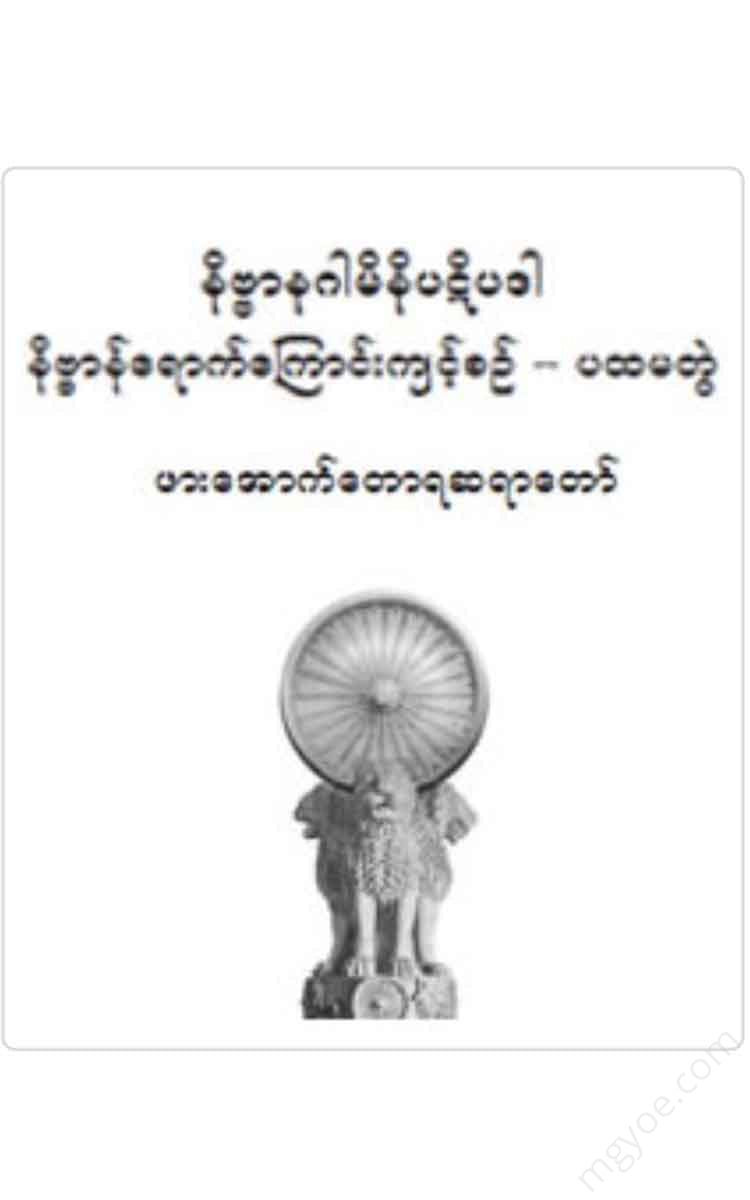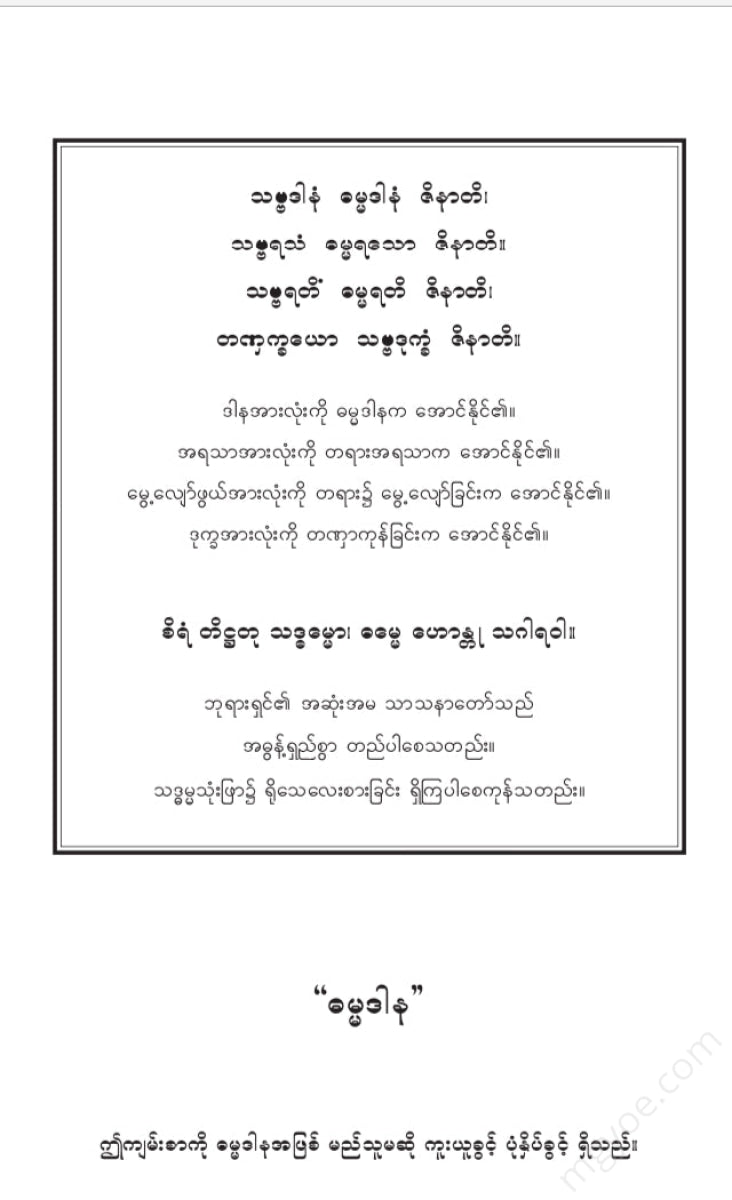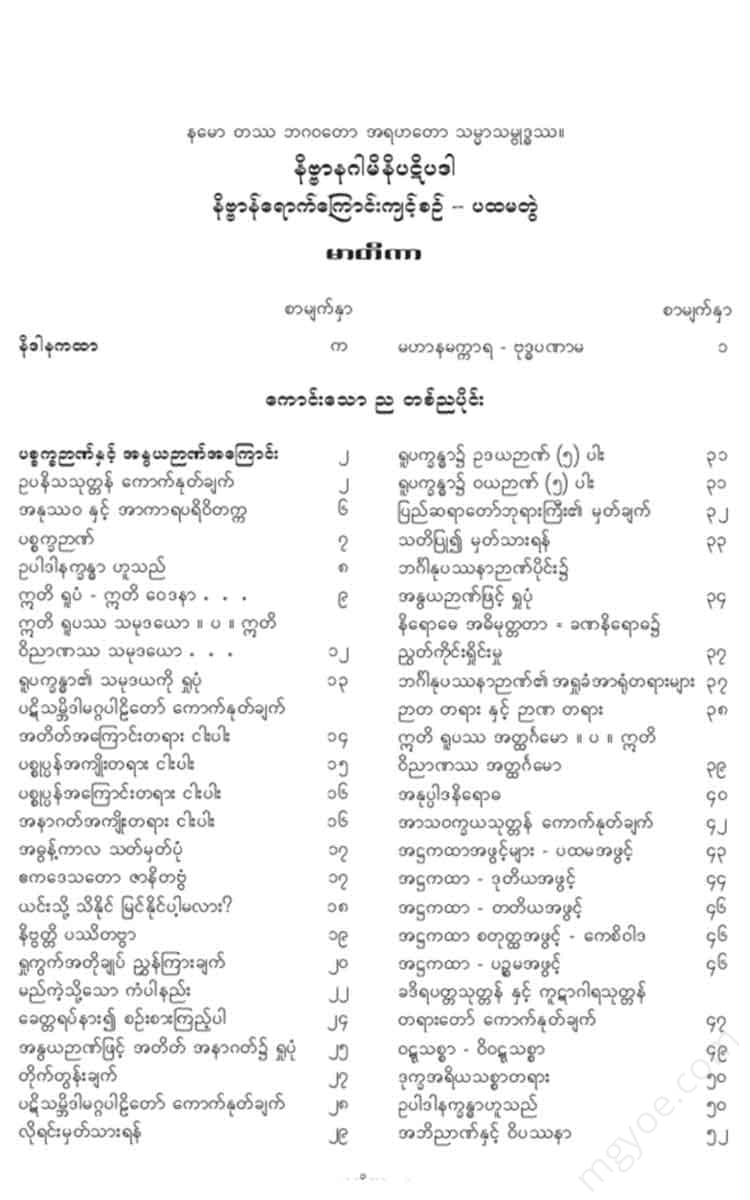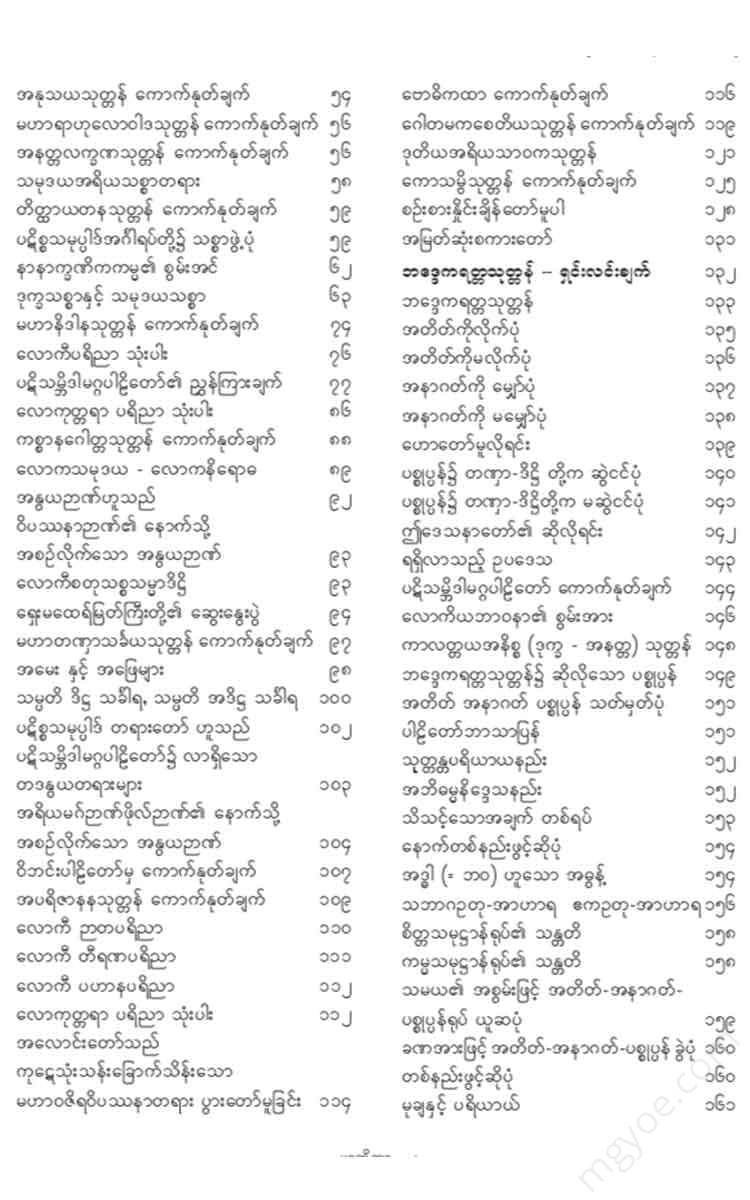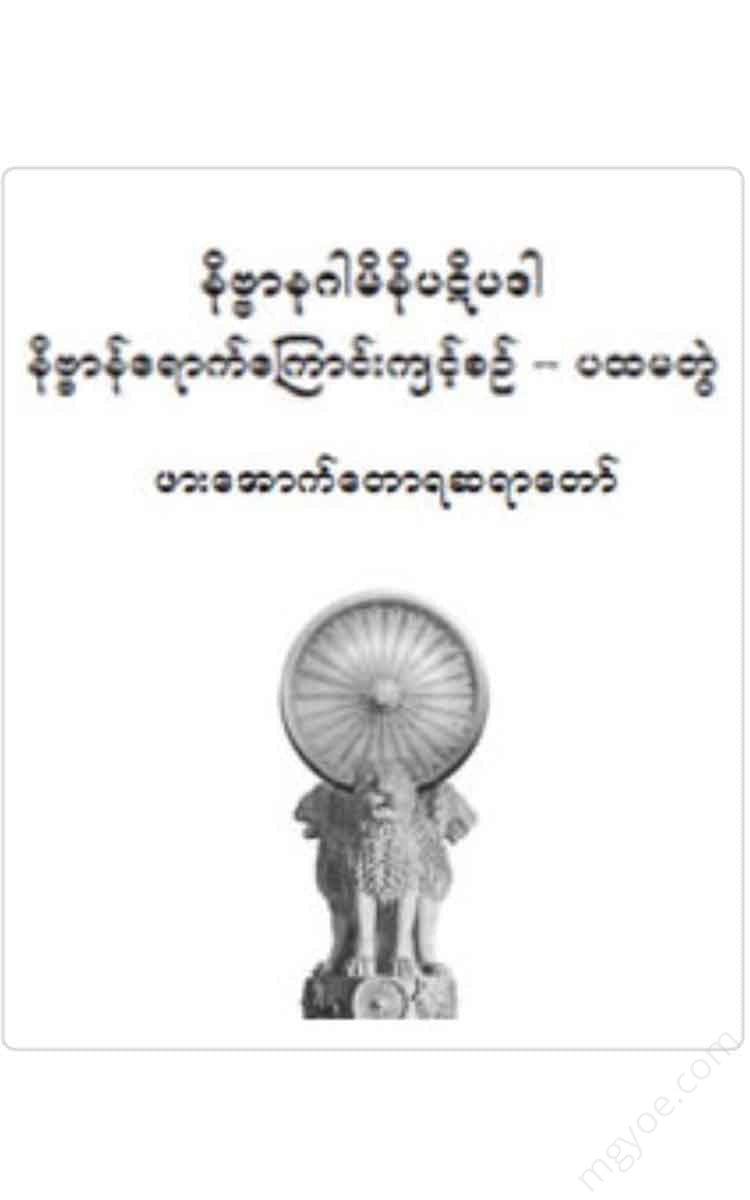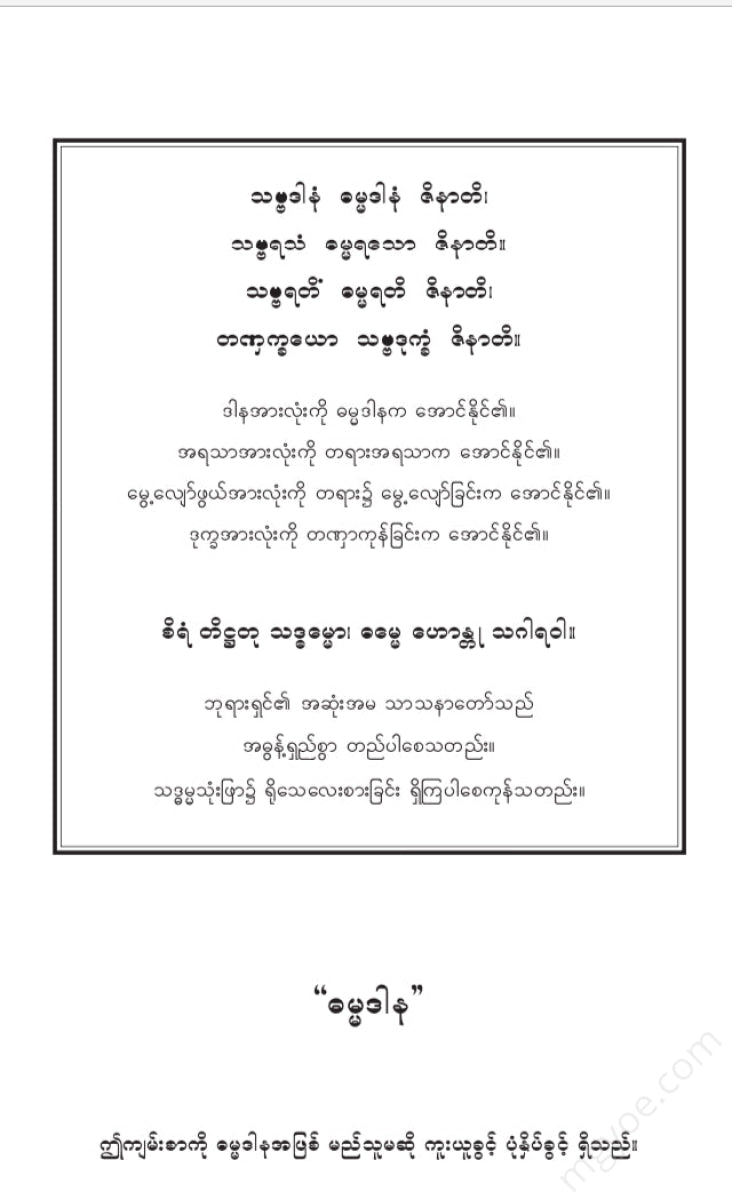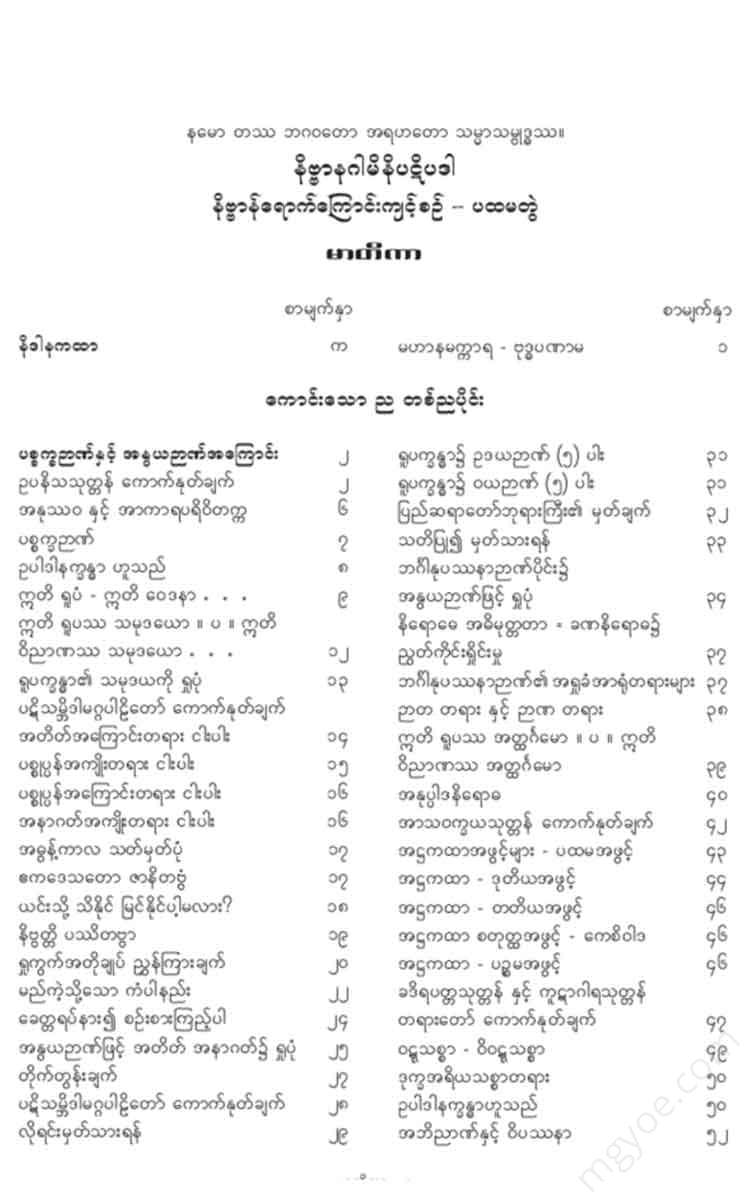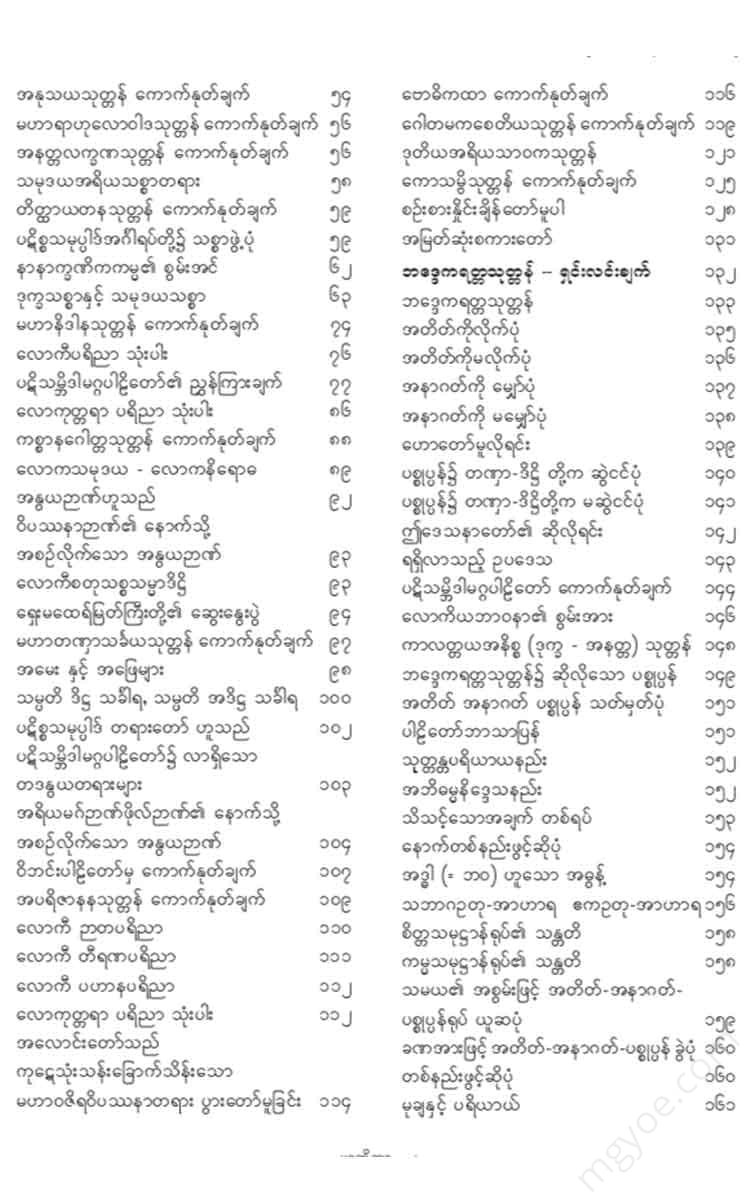Other Websites
The Venerable Phor Aok Tora Sayadaw - The First Part of the Journey to Nibbana
The Venerable Phor Aok Tora Sayadaw - The First Part of the Journey to Nibbana
Couldn't load pickup availability
All human beings who live in the world, blinded by the eyes of divine wisdom. Yama = Those who see men and women. Pasati = Those who live in the world, wrongly and erroneously (as men and women) through false philosophy.
Ta = All human beings who are blinded by the eye of divine wisdom are men and women who are mistaken and mistaken. Dithi = What is the Dhamma that should be truly seen and worthy of being seen with the eye of divine wisdom? Na = Not.
Yama = (a) What vision, (b) What hair and other bodily features, ( c) What physical forms, all forms of beings, all beings of the world
ता = All the wise and good people should really see with the eyes of wisdom (a) that vision. (b) all the hair and other things , ( c) all the forms of the body and the body. All the human beings who live in the world with the eyes of wisdom. With the eyes of wisdom, the eyes of wisdom. With the eyes of wisdom. Without knowing it, they do not see.
The one who does not see with the eye of the supreme wisdom, the one who does not know the truth, the one who is confused and confused, the one who is bound by the desire for pleasure. The
(Abhi, 8th, 2207. De, 8th, 2,347. Ma, 8th, 1,247. Mulakti, 2,148.)
A human being, having the eye of supreme wisdom, calls vision as vision, all the hair and other bodily parts as the aggregate of hair and other bodily parts , the aggregate of physical and mental forms as the aggregate of physical and mental forms , the aggregate of name-forms as the aggregate of name-forms , the aggregate of cause and effect as the aggregate of cause and effect , the aggregate of impermanence, suffering, non-being, non-existence, and non-existence, without knowing with the eye of supreme wisdom what is right and what is wrong, and sees things as men and women, etc., in error and error. Such a person, who is confused and confused, is bound by attachment to the senses, such as men and women, and is bound by the law of desire. Such a person, who is bound by the law of desire, cannot escape from this cycle of three conditions: defilements, actions, and delusions.
A good person is one who is endowed with the wisdom of true vision, the eye of supreme wisdom. . . . .
1. Vision is called vision,
2. The aggregate of hair and other physical objects is called the aggregate of hair and other physical objects,
3. The body, which is the aggregate of physical and mental forms = all physical phenomena are called the aggregate of physical and mental forms,
4. Nama-kaya = the aggregate of nama-dharmas, and nama-kaya = the aggregate of nama-dharmas.
5. The aggregate of causes and effects is also called the aggregate of causes and effects,
6. The aggregate of impermanent states, the aggregate of suffering states, the aggregate of emptiness states, the aggregate of death states, are also called the aggregate of impermanent states, the aggregate of suffering states, the aggregate of emptiness states, the aggregate of death states.
He sees with his own eyes the wisdom of true vision, the eye of supreme wisdom. The good man who sees without being distracted and without being distracted cannot be bound by desire. He who is not bound by desire is free from the defilements, is free from the suffering of samsara.
This is the meaning of the above verse.
The view of a human being whose eyes are not fixed on the Supreme Being is different from the view of a wise person who is endowed with the true vision of the Supreme Being, the eye of wisdom, which is fixed on the Supreme Being. A human being whose eyes are not fixed on the Supreme Being does not see the Supreme Being, but a wise person who is endowed with the eye of wisdom sees the Supreme Being.
Regarding this verse, the ancient sages said:
1. See, see, don't see.
2. I only hear, I don't hear,
3. It smells bad, but it doesn't smell good.
4. The taste is pleasant, but I don't know the taste,
5. Slightly touched, I don't know, 6. Clearly known, I don't know -
Thus he speaks of the error found in all six senses. (Commentary on the Sammoha Vinodani, Volume 2, 286.)
These are the sayings of the ancients, referring to a human being who is struggling with the unseen wisdom that leads to the attainment of God.
If you, the good disciple, wish to be free from the suffering of samsara, you must systematically practice and strive to develop the eight noble qualities of conduct, guided by the right view, the eye of wisdom that pierces and sees, as instructed by the Buddha in the Pali Canon and the commentary on the Atthakatha.
The book that explains the eight (8) paths of practice in a systematic and complete manner according to the Buddha's teachings in Pali is the Visuddhimagga Atthakatha .
The Covenant and Oath of the Visuddhimagga Atthakatha
The Sudullābi Labitvāna, the Pāvāzōmā Jīnasāsāne.
The siladhisingaham kemam, the uzon magga visuddhiya.
The Buddha is the one who
"Vishuddhi" is the essence of the mind, the essence of the body,
This is the teaching of the Buddha, the Suvisuddhavinicya.
Mahaviharavatsina, the place of teaching.
The Buddha is the one who
The desire for pleasure is the same as the desire for pleasure, and the desire for pleasure is the same as the desire for pleasure.
(Visuddhi, 1, 2.)
Within the Buddha's teaching, they have attained the very difficult status of monks, and by virtue of the three virtues of morality , concentration, and wisdom, they have been able to avoid the dangers of the defilements and robbers, and by abandoning the various defilements such as the yoga of self-indulgence, the yoga of sensual pleasure, the yoga of falsehood
Because they do not know everything correctly, even within this sacred teaching of the Buddha Gotama, they long for the Nibbana of Arahantship, and because they are constantly diligent in the twofold meditation of Samatha and Vipassana, the noble men and women who are called virtuous yogis strive to attain the Nibbana of Arahantship and develop the Dhamma, but they are unable to enter the Nibbana of Arahantship, which they have originally intended, and they are unable to attain it.
The way of explaining the Dhamma, the way of chanting the Dhamma, and the way of teaching, of the Venerable Satodhitoradhathi, who is the joy of all the yogi saints, who is not mixed with the doctrines of other sects, and who dwells in the great monastery of Mahavihara, which is especially pure and well-established, is followed.
I will write and present the book of the Visuddhimagga. May all good people, good masters, and good masters who are longing for the attainment of arahantship and Nibbana, listen to this book of the Visuddhimagga, which has been explained and explained by his disciple with great respect and reverence, with great respect and reverence. (Visuddhi, 1, 2.)
In accordance with the above covenant, after the passing away of the All-Wise, All-Perfect, and All-Merciful Buddha, who is the true object of worship for the whole world, in about the year 973, the Venerable Mahabuddha Ghosama Thera, residing in the Mahavihara monastery in Anuradhapura, Sri Lanka, wrote the Six-Way Path, based on the commentary of the Venerable Dhanadhitawaravathi, the Dhamma Samvannana, and ordered his disciples to write the Six-Way Path.
Unlike the writings of monks from the northern sect, such as Ashin Assajasatha, Arunavajjana, and Ashinsar, Mahabuddha Ghosa's writings do not contain any special and unusual Dhamma statements that he has invented and written with his own intelligence, without relying on the great Pali texts and ancient Atthakatha texts. He only presented the old ways and practices that were found in the Pali texts and the Maha Atthakatha, and did not invent new methods, systems, or paths. To illustrate this point, I will now briefly summarize some of the practices presented in the Visuddhimagga Atthakatha.
1. In this book called the Nibbānagamini Patipāda, the section on the establishment of concentration describes the section on anapaṇasati samadhi. In the Visuddhimagga Atthakatha, this section on anapaṇasati sadhasinō is taken from the Vinaya Atthakatha, which he himself translated and named the Sānta Pasadika Athatha.
2. The book of Kāyāgatasatikāna called Patikulamanāsīkāra, and the book of Kātakasāna called Satūsātusāsāttananubhavana, a brief and detailed commentary on the book of Kātakasāna, were taken from the Abhidhamma Aṭhākatha, which he translated himself, under the name of Sasawāvinodāni Aṭhākatha.
3. Of the two types of concentration, Upasara Samadhi and Appana Samadhi, the one that is the foundation of Vipassana and the one that is the higher stage of Visuddhi, the one that is the foundation of Vipassana, the one that is the foundation of Vipassana, the one that is the foundation of Visuddhi
4. The aspects of the attributes, attributes, attributes, attributes, attributes of the Supreme Being are taken from the Atthasalini Attha Katha and the Vibin Attha Katha and are presented in writing.
5. Similarly, the Ayatana Niddavata section is from the Ayatana Vibin Atthakatha.
6. The chemical composition of the Niddatha is from the Sattu Vibin Attha Tatha.
7. The Indian Niddah region is described in the Inratha Vibin Atthakatha.
8. The history of the Sissa Nivattha is presented in detail, extracted from the Sissa Vibin Atthakatha.
9. In particular, the section on the practice that yoga practitioners themselves must practice to attain the insight of the mind is taken from the Salasuppadic Inka. The section on the concept of mind is also taken from the Abhidhamma.
10. On pages 300-301 of the second volume of the Visuddhimagga Atthakatha, various types of insight into the Vuttha Dhana Gami Ni Vipassana are described.
(a) By simply contemplating the five aggregates of consciousness alone.
(b) By simply contemplating the five external aggregates.
(c) By simply contemplating the physical form,
(d) By simply contemplating the four mental bodies -
He has decided that the Vudhanagami Nivipassana is impossible - that it cannot lead to the Noble Path. In it, he has extracted the conclusions regarding the (9) Vudhanagami Nivipassana from the Abhidhamma Atthakatha, which he himself translated and named the Atthakatha. It is an ancient law that all good people who desire Nibbana, who love the true Dhamma, who know and see, who are desirous of Nibbana, who are willing to practice and strive according to the old path, the old system, and who want to develop, should respect and heed it.
It is true that the Venerable Mahabuddha Ghosa composed and wrote many Atthakathas, but he did not write them out of his own imagination or intelligence, but simply translated the Atthakathas that existed in the Sinhalese language into Pali. Let me explain a little more.
The venerable Mahabuddha Ghosha Sayadaw, having received a request from Sinthiri Jeth for the Vinaya, the Mantapasadika, was the founder of the Mahavihara monastery.
He lived and preached in the palace of Dayaka, named Anisa, in the south of Anuradhapura. The Venerable Mahabuddha Ghosa, who wrote the Vinayaka Atthakatha, took the Sinhalese version of the Sakaka Atthakatha, which had been brought to Ceylon by the Venerable Mahasatirahanta himself, as the body of the new Atthakatha, and took what was appropriate from the Mahapisari , Kurundi, Sangha , and Andaka Atthakathas, and also included the Theravada, which was the final ruling of the ancient Vinayakas, which had been prominent in Ceylon up to the time of King Satta. Therefore, the following words are spoken in the Vinayaka Atthakatha: -
I (Buddha Ghosama Thera), who have endeavored to compose the new Atthakatha, will endeavor to compose the new Atthakatha well, taking the great Atthakatha as the basis of the new Atthakatha , and the conclusions stated in the Maha Pisari Atthakatha, and in the old Atthakathas such as the well-known Kurundi Atthakatha, and not abandoning the appropriate interpretation from those conclusions, and will also endeavor to compose the new Atthakatha well, which includes the Theravada teachings of the great Theras, such as the conclusions of the venerable Tipitaka, the Sulanaga, and other great Theras.
(V, V, 1, 2.)
1. Sumangalavilasini, the eighth chapter of the Jigā Nikāya.
2. From a Roman Catholic priest named Savage
3. The Samyutta Nikaya Jātra, named Sārat Kapapākasthāni ,
4. The Dhājanārāta Purāṇī, the Eighth Chapter of the Anguttara Nikāya ,
5. The Abhidhamma Attha Katha, which is called Atthasalini , Sajammahavinodani Upakaran .
He also composed all these Atthakathas. The way he composed them was that the Venerable Maha Mahinda Thera, who had brought them to Ceylon as a monk, translated them into Ceylon , and wrote them down in Pali, by translating only the original Atthakatha, called the Maha Atthakatha, into Pali, and by omitting the repeated words. Therefore, in the preface to the Atthakathas, he said as follows -
“After the Third Sanghayana was held, in a later period, the venerable Arahant named Maha Mahinda brought the original Atthakatha to Ceylon by way of ablution and set it down in the Sinhalese language for the benefit of the Ceylonese. | Having removed the Sinhalese language from the old Atthakatha, he set it down in the Pali language, which is pure and pleasing to the heart, in accordance with the Pali method. P. I will set down the repeated interpretation and explain the interpretation of the Pali (Atthakatha).” (Di,th,1,1-2. Abhi,th,1,2.)
Again, the Venerable Mahabuddha Ghosha Sayadaw has also stated the following in the beginning of the Atthakatha:
1. Words that explain virtue,
2. The Dhutin practices, and...
